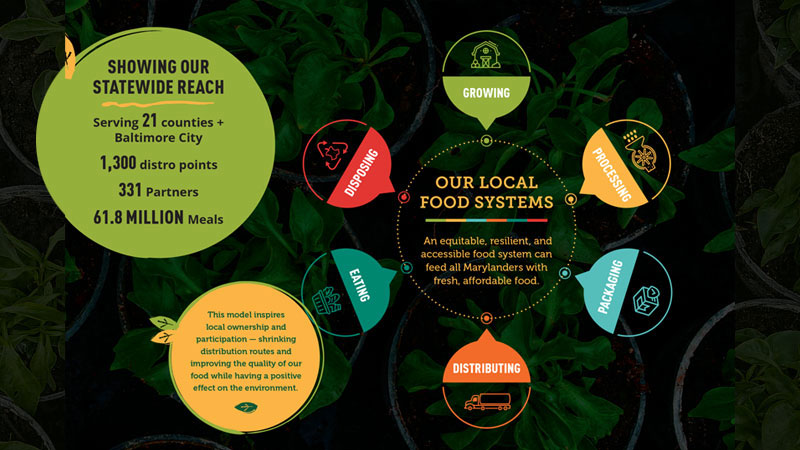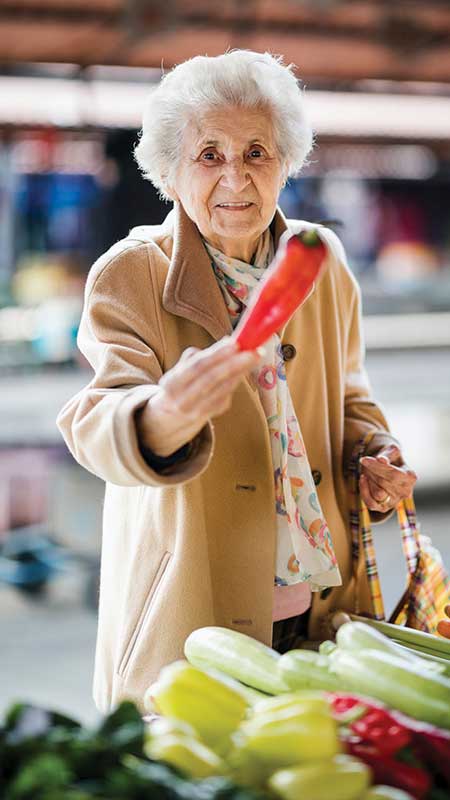Local Focus, Statewide Difference

If the past few years have taught us anything, it’s that a strong foundation is our best line of defense against unforeseen challenges. So as we stared at empty supermarket shelves when the pandemic first hit Maryland, we came to understand the food we eat often traversed the global supply chain, rather than coming from a local farm or fisherman.
Beyond making our food supply vulnerable to disruption, this approach undermines the viability of local, responsive food systems. That’s why, to fully realize a more equitable, resilient, and accessible statewide food system, we must focus on strengthening the local elements, from traditional farms and orchards to the rapidly expanding aquaculture industry that can provide protein and produce while protecting the environment.
The Food System Resiliency Council (FSRC) brings together a broad range of practitioners, experts, advocates, and state agencies to strengthen Maryland’s food system. This includes growing, fishing, processing, and distributing more local foods and increasing the capabilities of local communities to be more self-sufficient by adding new resources, and better linking existing ones.
“At MFB, we have an unparalleled reach in Maryland and more than 43 years of food assistance experience, uniquely positioning us to educate decision-makers about the current reality of food insecurity in Maryland and bringing the full-force of our statewide network to the table.”
Laying the Foundation in Maryland
Maryland’s food system mirrors national trends wherein food is produced for sale, and not to feed local communities. This shift has happened over the past hundred years, as our economy industrialized and became more global. The pandemic exposed the shortcomings of this approach, and the FSRC is designed precisely to ensure that more of Maryland’s agricultural and aquacultural activities benefit Maryland residents, especially those who are food insecure.
We believe it’s important to be on the FSRC alongside the Capital Area Food Bank because of the outsized role the two organizations play in keeping food on the table for 1 in 3 Marylanders.
We’re proud of our Farm to Food Bank and FoodWorks programs which have been paying tremendous dividends for more than a decade in our state by helping to strengthen local food systems and creating pathways out of hunger for more Marylanders.
And state officials are helping to fuel future efforts by allocating $200,000 in funding through the MD FARM program to not only broaden the types of produce we’re buying from state farmers, but also introduce locally sourced, nutrient-rich proteins and farm fresh dairy products. But we’re not waiting until this support kicks in in 2024.
From orchards in Western Maryland to seafood providers outside Baltimore to the farms and ranches on the Eastern Shore, we’re making sure all residents have access to locally grown and produced foods.
“The need for fresh produce doesn’t end when Maryland’s relatively short growing season ends, so we’re developing partnerships and seeking the funding to quick-freeze these nutritious, Maryland-grown fruits and vegetables so our neighbors have access to them all year long.”
UMES Cultural Crops
We’re excited about the power of making locally sourced fresh foods more widely available so that all Marylanders can enjoy the benefits of a healthy diet, especially fruits and vegetables that are more familiar to some of our Maryland communities.
In the summer of 2021, MFB’s Director of Nutrition, Kate Long, alongside our Farm to Food Bank Coordinator Amy Cawley began discussions with the University of Maryland Eastern Shore (UMES) about a project investigating new ways to grow ethnic food crops.
The pilot project is made possible by a $600,000 USDA grant to UMES that responds to increased demand for locally grown food and ethnic crops. Food like lalo, okra, and certain varieties of peppers traditionally grown in the Caribbean, Africa, and Southeast Asia will be grown here in Maryland! The grant also allows the UMES team to study sustainable techniques to grow plants — including purslane, amaranth, and hibiscus — outside of their usual environments.
“We’re in discussions with the university’s demonstration farm (which sells the crops it produces) as well as its farmer network to purchase these crops for distribution to food pantries that serve individuals for whom these vegetables are a large part of their cultures’ traditional dishes—it’s an exciting initiative for Maryland farmers, and we look forward to watching it unfold.”


This pilot program is a microcosm of what a stronger local food system looks like. A community-led food system produces the food that neighbors need and want, providing families with access to fresh, local, and nutritious ingredients for their meals.
We’re adding to Maryland’s resiliency and strengthening local food systems by developing innovative partnerships and programs, and expanding into other Workforce Development sectors – but we’re just getting started!
Get updates on our progress in the fight against hunger
Want to see how your involvement directly impacts the well-being of your neighbors in need? Get the latest news sent to your inbox.







